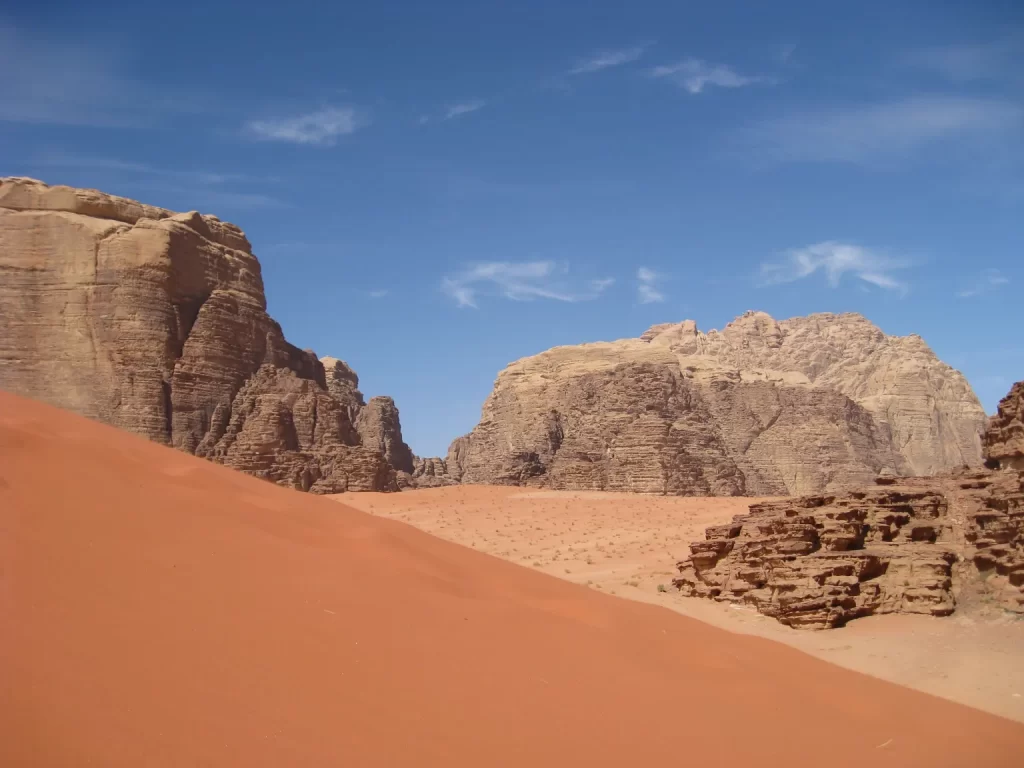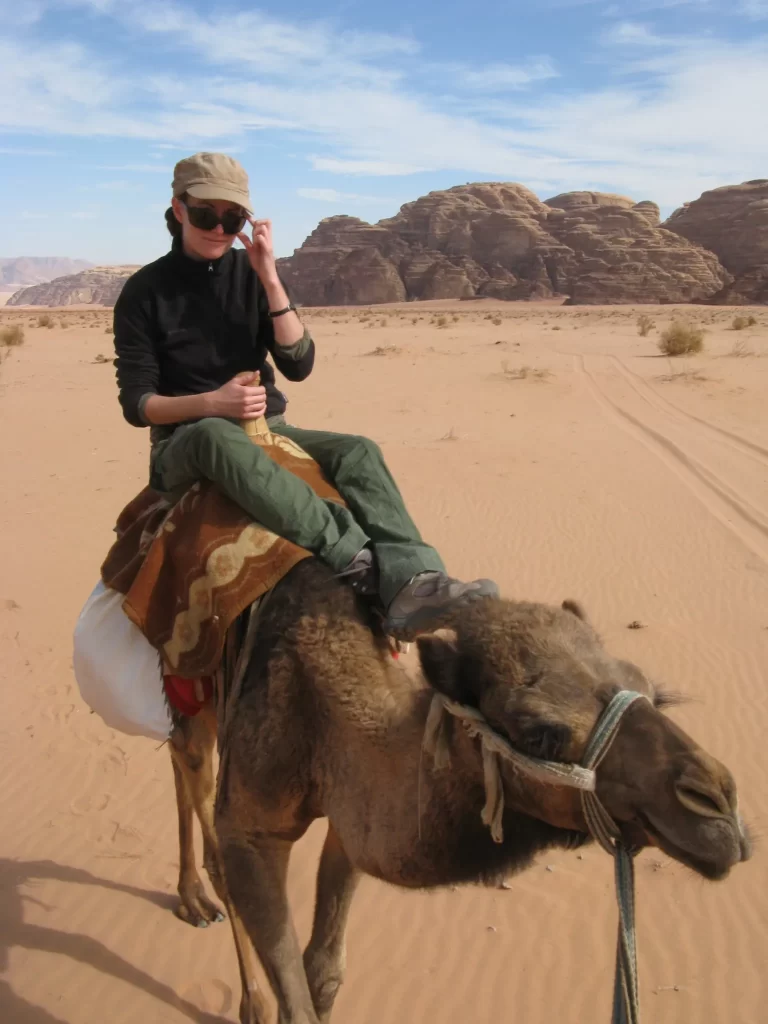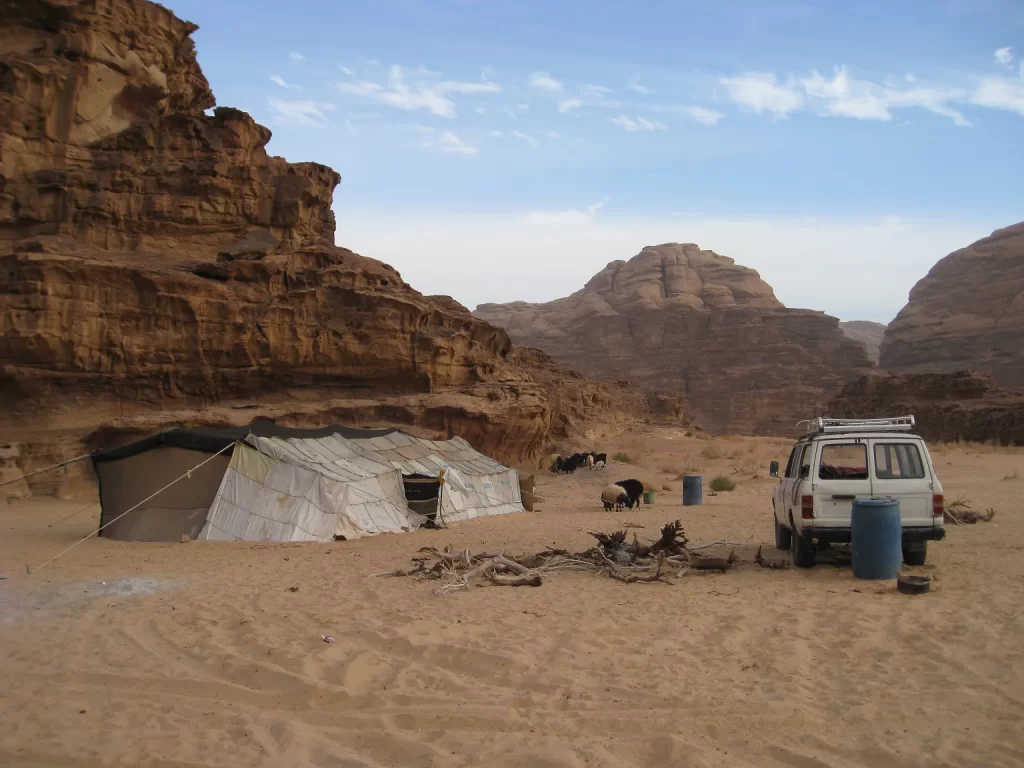
GO JORDAN: Retrace the steps of T.E. Lawrence, and lodge with a Bedouin family in the magnificent desert of Wadi Rum in Jordan and you are sure to be smitten, writes RÓISÍN SORAHAN.
I COULDN’T understand a word, but their intimacy was obvious. Black-kohl eyes danced above the glow of a cigarette. Her deep, coarse laugh blared confidence. Her husband, capable and strong, smelled of camels and desert sands. The cigarette passed between them and we were forgotten for a time as we lounged on the mattress spread by the fire, eyes smarting as the smoke thickened the air of the Bedouin tent.
We had travelled to Wadi Rum desert, a protected area in the south of Jordan, just one day earlier. Crossing sand dunes on camels, it felt like we’d journeyed much further. Arriving at this goat-hair tent, our rest-stop for the night, we encountered a lifestyle that had hardly changed in centuries. There was no television or any fixed furniture. Possessions were counted in herds and our nomadic hosts relied on their desert skills for survival. We were eons from our world of iPhones and cable.

The temperature dropped as the night deepened and the children circled closer to the warmth. The man poured sweetened tea, re-filling our cups with a nod. We settled into the uncomplicated silence of strangers who had shared a meal and a fire, and watched this other life play before us.
The drama began the evening before as we stepped off the bus on a desert road. There was only one path and it led towards a range of low sandstone mountains, where the sun was already beginning to set. We hadn’t arranged a guide or a pick-up, preferring to get a sense of the place before we committed to a tour. A truck was parked by the road-side and, with some negotiation, we climbed on board and waited while it filled with women wearing black jalabiyya robes.
We were deposited at the recently constructed visitor centre, where we paid an entrance fee to Wadi Rum, a gorgeous area renowned for its inhospitable landscape and its epic scenery.
It has tumble-down dunes, scramble-up mountains, wandering camels, ancient rock graffiti, and bona fide nomadic tribes of Zalabia Bedouin. It’s the stuff of 1960s movies, riddled with romance, turbaned men, scorched desert and wistful music played under an impossibly star-laden sky. Lawrence of Arabia was filmed here, depicting the controversial T.E. Lawrence’s exploits during the Arab revolt against the Ottoman Empire during the first World War.
More prosaically, the Bedouin population has come to recognise the economic rewards of capitalising on the natural beauty of the landscape and their intimate knowledge of it. A local co-op has been formed and is managed through the visitor centre where tourists can view exhibitions and book 4X4, camel and horse-back tours offered by Bedouin guides. The alternative, and usually cheaper, option is to contact a recommended guide directly. The co-op requires that the guide receives a fax or e-mail confirmation 48 hours prior to the visitor’s arrival. The idea is to circumvent tour agencies and hotels scooping up the business and creaming off the fees through commission.
We took an alternative route. We flagged a jeep travelling from the centre to the village of Rum, which is 6km away, where we figured we could talk with the guides and look at our options.
The village, which houses about 1,000 settled Bedouin, is a ramshackle affair on the lip of the desert valley. There’s one rest-house, which was originally built to accommodate the crew who filmed Lawrence of Arabia in 1962. Prior to this, the only man-made constructions in the valley were the tents of the Zalabia who moved their herds to watering holes and grazing patches.

On arrival, we were greeted by tour-guides and drivers, anxious for our business. Camels were paraded before us to admire, but we settled comfortably into the rest-house which provided us with a tent, bedding and a hearty meal.
Later that night we wandered through the village, necks craned, gazing at the stars. The village was dimly lit and the jagged line of mountains cradling the settlement could be clearly seen against the sky. The road petered off and finally conceded to the expanse of desert before us. Then we heard a soft voice: “Is there anything that I can help you with?”
A dark head and easy smile emerged from under the bonnet of a jeep. Tools were laid down and conversation sparked up. The man, wearing the traditional kufiyya cloth head-gear of the Bedouin tribe, invited us to his home. We were in search of a guide and negotiations of this nature, he assured us, could not be rushed. First, we must drink tea.
We followed a warren of lane-ways before pulling into a long, low structure. Inside we settled on cushions and a tray of sweet tea was laid before us by a young boy who manfully tried not to stare, then gave up in a fit of giggles. Our host, all eyes and black hair, cradled his oud, an ancient Arabian instrument similar to a lute, and talked in poetry about sleeping under desert skies. His words painted canyons, dunes and camel-racing, before petering into silence softened by his gentle strumming.
We had come looking for a guide to lead us through the desert. Fatefully we had met this man. The hard sell and brass tacks were forgotten. I simply hoped he would deign to accompany us. The tables had turned. Along with my head.
My partner wasn’t as smitten so, as I fell into reverie, he negotiated the cost of spending two nights in the desert, travelling in turn by jeep, camel and on foot. We arranged to depart at sunrise the next morning and we returned to the rest-house where we spent a peaceful night under a nest of blankets.
The following day we drove for a while through desert landscape before getting out and climbing on camels. Mine was a feisty young thing. A mass of long legs and youthful exuberance. After the initial excitement, however, the camels took stock of their riders and settled into the pace of a slow heart-beat.
We spent the rest of the day in the saddle, stopping only to tumble down talcum-soft dunes; clamber across wind-carved stone archways; and scramble up sandstone formations, with hundreds of footholds shaped out of bleeding rock. When the sun grew wearisome, we lounged under an overhang to eat home-made hummus, baba ghanoush, pita bread and eye-wateringly spicy salsa. Finally, on the watery horizon, we watched the sky explode into a firework sunset.
Weary and bone-jarred, I was relieved when our mounts rounded a boulder and we were in sight of our home for the night. Our Bedouin hosts had pitched their tent in the shelter of the rocks and we arrived to the clamour of goats and the sounds of dinner being cooked over an open fire. We settled comfortably into the chaos, shared the family’s meal, which we ate from the pot with our fingers, and waved off our guide who had been called back to Rum as his racing camels – his pride and joy – had bolted.
The night brought an easy sleep – disturbed only by a desert mouse under my blankets who sampled, then spat out, my finger before fleeing the scene. Unwilling to wake the family who snored softly behind a curtained partition, I stifled horrified giggles before tightly tucking my blankets around me.
Arising before dawn, I slipped outside and climbed to the highest point. I had never been anywhere so silent. The desert was as quiet as freshly fallen snow. From my vantage I watched the woman herd goats across the valley floor, a black asaba cloth wrapped around her forehead.
The sun rose and our second day in the desert began. Our guide dropped us off at the mouth of Barragh Canyon, promising to meet us on the other side. We sauntered slowly between its gloriously shaded over-hangs, stopping to watch camel herders squat over fires heating billy-cans, or to crane at climbing teams, strapped and harnessed, mere specks of colour in the distance.
Days in the desert, it seemed to me, were marked by shifting colours. Soft dawns, leading to brilliant mornings, followed by changing rock-hues and full-palette sunsets. It was the sky, and the mouse, that convinced us to abandon the tent on our last night and sleep on mats under the stars.
Our guide cooked a rich stew over the fire, after which he played achingly beautiful music and invited us to stay. We could exercise his horses, he offered. It wouldn’t pay much, but then . . . he gestured at the dazzling sky above us and miles of desert before us.

That my partner had encountered few horses growing up in LA and I was a passing poor rider, at best, hardly crossed my mind. Of course we would stay. I wasn’t delirious for lack of water. It was the desert talking. The morning blossomed. The offer remained open. We could learn to ride. We returned to Rum and the fever abated, ever so slightly. Not on this trip, I conceded. But maybe, next time.
Wadi Rum desert
Location
Wadi Rum is located 322km from Amman, 114km from Petra and 70km from Aqaba.
Admission
Admission to Wadi Rum Protected Area is tightly controlled. It costs 5 JOD (€5.30) to enter.
Website
For more information on guided tours visit wadirum.jo.
Don’t forget . . .
Bring a brimmed hat, sun-protective clothing and sun-screen. Pack appropriately for cold nights and bring a flash-light and toilet-roll.
Stay
Wadi Rum Resthouse is basic, but the only show in town. Tel +962-3-201-8867
Get there
Direct flights from Dublin to Amman, which is the capital of Jordan, are plentiful. See the following: airfrance.com; flybmi.com; lufthansa.com; etihadairways.com; and turkishairlines.com.
© Róisín Sorahan
Article originally published by The Irish Times